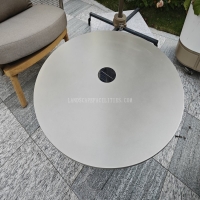Welcome to the website for landscape facilities products and knowledge.
How do landscape bar counters accommodate outdoor ceiling fans or cooling systems?
Creating the perfect outdoor entertainment space requires a delicate balance between aesthetics and functionality, particularly when incorporating climate control elements into landscape bar counters. The integration of outdoor ceiling fans and cooling systems presents unique challenges and opportunities for homeowners and designers seeking to enhance comfort without compromising style.
The fundamental consideration begins with structural assessment. Landscape bar counters, typically constructed from durable materials like stainless steel, teak, or weather-resistant composites, must be designed to support additional weight and vibration from overhead fans. Cantilevered designs often provide optimal solutions, allowing for unobstructed airflow while maintaining the counter's clean lines. For permanent installations, reinforcing the overhead structure during initial construction proves most effective, whereas retrofitted solutions may require specialized mounting brackets designed for outdoor use.
Electrical planning constitutes another critical aspect. All wiring for outdoor cooling systems must comply with local safety codes, typically requiring waterproof conduits and GFCI-protected outlets. Many designers now recommend integrating power sources directly into the counter's infrastructure during construction, concealing wires within support columns or underground conduits. Solar-powered fans have emerged as an innovative alternative, eliminating wiring challenges while promoting sustainability.
Spatial dynamics significantly influence cooling effectiveness. The optimal fan blade clearance of 7-9 feet above the counter surface necessitates careful planning for both standalone and built-in counters. For low-profile designs, flush-mount ceiling fans provide sufficient airflow without compromising headroom. In environments requiring more robust cooling, misting systems integrated into the counter's perimeter or overhead pergola offer enhanced temperature reduction. These systems can be discreetly installed within counter edges or overhead beams, emitting fine water particles that reduce ambient temperature by up to 30 degrees Fahrenheit.
Material compatibility remains paramount when combining water/mist systems with bar counters. Non-porous surfaces like quartz composite or powder-coated aluminum prevent water damage and mineral buildup. Proper drainage systems must be incorporated into the counter design when using misting technologies, with slight slopes and discreet drainage channels preventing water accumulation.
The aesthetic integration separates exceptional designs from merely functional ones. Modern outdoor fans feature weather-resistant finishes that complement various design themes – from industrial black matte for contemporary spaces to oil-rubbed bronze for traditional settings. Custom enclosures can camouflage larger cooling units while maintaining accessibility for maintenance. Strategic lighting integration often enhances both form and function, with fan-mounted LED kits providing illumination without additional fixtures.
Maintenance considerations significantly impact long-term performance. Outdoor cooling systems require regular cleaning to prevent debris accumulation in fan mechanisms and misting nozzles. Quick-disconnect features for removable fan blades and accessible filter systems simplify upkeep. For coastal properties, corrosion-resistant components become essential to withstand salty air conditions.
Ultimately, successful integration of cooling systems into landscape bar counters demands collaborative planning between architects, HVAC specialists, and outdoor living designers. By addressing structural, electrical, and aesthetic factors during the initial design phase, homeowners can create seamless outdoor entertainment spaces that deliver both visual appeal and unparalleled comfort in various climate conditions. The result transforms ordinary outdoor areas into climate-controlled extensions of living spaces, maximizing usability throughout changing seasons.
Related search:

Recommendation
Outdoor stainless steel table with solar-powered ambient lighting feature - excellent design.